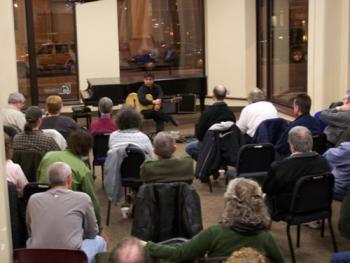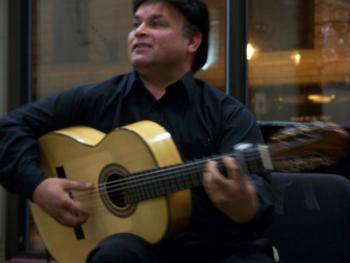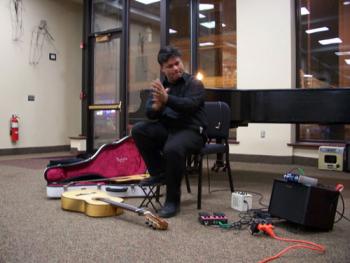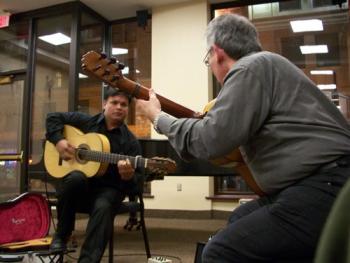Mir Ali Talks About Flamenco Guitar (November 11, 2007)
The Rochester Guitar Club’s November meeting was held at Messenger Hall in the Eastman School of Music Community Division on Gibbs Street. The Eastman School cosponsored the event and provided the space for the presentation. Located at the corner of Gibbs Street and East Avenue, two adjacent walls are completely glass and provide an interesting backdrop to the performance inside. Passersby are visible going about their usual business which is often music school related. The room is well suited to a guitar presentation without amplification. It is large enough to hold the forty or more members and guests in attendance, but small enough to allow the quiet sounds of classical/flamenco guitar to be clearly heard in every part of the room. The school provided refreshments.

Mir Ali meets the crowd.
Mir Ali, our presenter this month, was born in Pakistan of Indian parents, and has resided in Buffalo since 1975. He was influenced by an aunt who played classical guitar and pursued a career in music in spite of his parentsí wishes for him to become a doctor. He grew up listening to vocal Sufi music as well as North Indian instrumental music. Mr. Ali is currently president of the Buffalo Guitar Society and Director of the Rantucci International Guitar festival and Competition. He is a world-class performer and a well-known teacher of guitar. Mr. Ali would be well qualified to present a variety of different aspects of guitar playing, but for this occasion, Flamenco was his topic.
Mir is attracted to various genres of music and Flamenco is just one of the many elements that he incorporates into his playing. He has long had an interest in international music. For the last ten years, he has traveled to Spain annually to study Flamenco. Even though, at first, he found it difficult to find a teacher there, he took some lessons with a local Flamenco guitarist, Ethan Margolis, who eventually introduced him to the Del Gastor gypsy family. Juan Del Gastor gave Mir lessons because he was already an accomplished classical guitarist and they thought he looked like a Gypsy and had an affinity for Flamenco. Mir came home with many CDís from Spain to study and soon noticed the similarity with Indian music. He played examples for us from both backgrounds to demonstrate this relationship.

His first piece was an Indian raga. This piece was accompanied by an electronic drone device known as “Raagni” This device simulated the sound of the stringed instrument known as “Tanpura” The raga began with a slow section introducing each note individually and establishing the very sad character of the raga. This was followed by 14-beat section (Deepchandi) organized in two groups of seven and concluded with a faster section in an eight-beat cycle known as gut in the Keharva rhythmic cycle. Indian music, much like Flamenco, is taught in the aural tradition and compositions are passed down from generation to generation. Both Flamenco and the North Indian traditions emphasize a highly developed rhythmic structure. Compas in Flamenco and Talas in Indian music. These rhythmic cycles are very often in meters not conventional in Western music such as seven, 9, 10, 12 and 16 Each cycle has many different rhythmic groupings with various permutations and gravitational points.
The rhythmic cycle in Flamenco is known as “compas” and is the most important element of Flamenco music. The equivalent term in Hindustani music is “talas.” The compas must be internally felt rather than mechanically counted. The tonalities also tend to be in modes other than our familiar major and minor scales, Phrygian being a scale commonly used. Within this framework, however, there is considerable improvisation without deviating from the compas. The short compositions played by the guitarist in between the song and dance are called falsetas. Flamenco music is rarely written, but passed down orally. Mir told us of his first lesson with a teacher in Spain who began the lesson by playing a complicated passage ad lib and then asked Mir to repeat it! He is now able to demonstrate that for us, but at that time, was overwhelmed by the experience. It is thought that the Gypsies may well have originated in India and traveled west over the centuries through Asia and the Middle East into Europe. There are many similarities between Indian and Gypsy culture including dress, language, food, etc.

Mir played on a Flamenco guitar as well as a hybrid sitar/guitar with two sitar strings replacing the fourth and fifth strings of the guitar. Strings were all tuned tuned to the tonic or fifth. Flamenco guitars are light in structure with a low string action which produces a very percussive and raspy sound desirable in this genre. Mir generally uses a capo at the second fret for reasons of tonality and to simplify the stretches on some chord patterns. Golpe plates similar to pick guards are also attached to the face of the guitar on either side of the sound hole to create a percussive affect and mark the important beats of the compas by hitting the plates with the fingers in the right hand. On his guitar, these were transparent and not noticeable at first.
After entertaining us with a Rumba, Mir invited an old friend from the audience, Dave Tamarin, to accompany him. Dave is also a competent Flamenco player and soon replaced “Pedro”, the loop machine that was accompanying Mir earlier. His guitar was furnished with white golpe plates and wooden pegs in the traditional Flamenco style.

Much of the music played began simply, sometimes defining a note at a time, and increased in complexity and tempo as the piece progressed. At times, Mir used his left hand to play across the strings in the lower positions to produce unusual effects. Another characteristic of his playing was to hold the guitar on the right leg as folk players do, rather than the left leg as in the classical style. He told us that he can and does play either way depending on the requirements of the music. There was very fascinating interaction between the two guitars quite distinct from solo playing. Flamenco guitar, traditionally was used as an accompanying instrument for dancers and singers and was not considered as an independent instrumental style. However, it is now commonplace to witness solo Flamenco guitar concerts. The guitar player must carefully follow the demands of the other performers, i.e., the dancers and singers. From everything that Mir explained, it seems like Flamenco is a life style, especially in the gypsy circles!
The many distinct styles of flamenco are known as palos and are based on various musical and non-musical criteria such as compas, mode, and chord progression. Sometimes even named after the city where they originated. Tonight we heard many fascinating examples of various palos including Tangos, Rumba, Solea, Allegria, and Buleria. Allegrias and Bulerias are serious Flamenco styles much like classical music. Rumbas and Tangos are more in the popular style. The Allegria originated in Cadiz and consists of twelve beats, similar to the Solea but with a very different character. Tangos refers to a Gypsy Flamenco dance not to be confused with the Argentinean Tango. Flamenco is passionate with a wide spectrum of moods. It can be sad and sorrowful, like much of the Gypsy poetry and art. It is comparable to the enormously popular works of the poet, Garcia Lorca. Gypsies accustomed to poverty used to steal cypress coffins to make their guitars, and in their music expressed their fear of the spirits who had resided in those coffins! In spite of Flamenco’s inherent sadness, it is full of lyricism and passion.
Mir Ali has introduced us to the complex and fascinating world of Flamenco with great passion and authority. Thanks to Mr. Ali’s skill and artistry the audience became acqainted with the expressive power of Flamenco in a delightful way.
R. Taglieri
Photos: K. Nelson
Share this page: ![]() Facebook
Facebook
![]() Del.icio.us
Del.icio.us
![]() StumbleUpon
StumbleUpon
![]() Digg
Digg
![]() Reddit
Reddit
Home ::
About Us ::
Events ::
Articles ::
Resources ::
Contact Us ::
Links
©2007-2008, Rochester Guitar Club, All Rights Reserved, This page last updated 2010-02-27 11:24:38
Website by Red Beagle Web Development.








